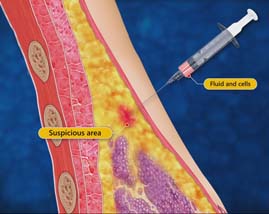Aspiration Cytology of Lump or Cyst

What is Aspiration Cytology?
Aspiration cytology is the most common method used for the diagnosis of a suspicious lump or cyst. The procedure may also be referred to as needle biopsy or fine needle aspiration and employs a hollow needle to remove small fragments of tissue for diagnosis. This procedure may be performed under ultrasound guidance for accurate placement of the needle and identification of the suspicious tissue lesion.
Aspiration Cytology Procedure
The procedure is usually performed by a specially trained radiologist on an outpatient basis. The site for the insertion of the needle is cleansed with an antibacterial agent. In some cases, a local anaesthetic may be administered around this region. A small amount of water-soluble gel is applied on the skin over the lesion and an ultrasound transducer is placed over it. The radiologist inserts the needle into the skin under ultrasound guidance to identify the location of the lesion for the sample. After the collection of the sample, the needle is removed, and pressure is applied over the site of insertion to stop the bleeding. If required, a bandage may be used for dressing. The sample is sent to the laboratory for evaluation.
Benefits of Aspiration Cytology
The benefits of ultrasound-guided aspiration cytology are as follows:
- Accurate placement of the needle for sample collection
- Less invasive
- Less painful
- Recovery time is short and you can immediately resume your normal activities
Risks Associated with Aspiration Cytology
The risks associated with aspiration cytology include:
- Bleeding at the site of insertion
- Infection at the site of biopsy
- Injury to the adjacent structures
